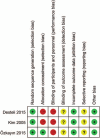Comparison of intramedullary fixation and arthroplasty for the treatment of intertrochanteric hip fractures in the elderly: A meta-analysis
- PMID: 28682912
- PMCID: PMC5502185
- DOI: 10.1097/MD.0000000000007446
Comparison of intramedullary fixation and arthroplasty for the treatment of intertrochanteric hip fractures in the elderly: A meta-analysis
Abstract
Background: More and more studies conduct to compare intramedullary fixation (IMF) with arthroplasty in treating intertrochanteric hip fractures, but it remains controversy. The aim of this meta-analysis was to find out whether IMF or arthroplasty was more appropriate for treating intertrochanteric hip fractures in elderly patients.
Methods: Relevant studies were searched in the electronic databases of PubMed, Embase, and The Cochrane Central Register of Controlled Trials from January 1980 to September 2016 with English language restriction. Surgical information and postoperative outcomes were analyzed using RevMan 5.3 version.
Results: A total of 1239 patients from 11 studies which satisfied the eligibility criteria were included. Compared with IMF, the use of arthroplasty reduced implant-related complications (odds ratio [OR]: 2.05, P = .02) and reoperation rate (OR: 7.06, P < .001), and had similar length of hospital stay (weighted mean difference [WMD]: -0.41, P = .63). However, IMF reduced blood loss (WMD: -375.01, P = .001) and transfusion requirement (OR: 0.07, P < .001), shorter operation time (WMD: -18.92, P = .010), higher Harris hip score (WMD: 4.19, P < .001), and lower rate of 1-year mortality (OR: 0.67, P = .02) compared with arthroplasty.
Conclusion: The main treatment of intertrochanteric hip fractures is internal fixation using IMF. In the absence of concrete evidence, arthroplasty should be undertaken with caution in carefully selected patient and surgeon should be aware of the increased complexity of doing the arthroplasty in these elderly patients. Further high-quality randomized controlled trials (RCTs) are needed to provide robust evidence and evaluate the treatment options.
Conflict of interest statement
The authors have no funding and conflicts of interest to disclose.
Figures










Similar articles
-
Hip Replacement as Alternative to Intramedullary Nail in Elderly Patients with Unstable Intertrochanteric Fracture: A Systematic Review and Meta-Analysis.Orthop Surg. 2019 Oct;11(5):745-754. doi: 10.1111/os.12532. Orthop Surg. 2019. PMID: 31663280 Free PMC article.
-
Proximal femoral nails antirotation, Gamma nails, and dynamic hip screws for fixation of intertrochanteric fractures of femur: A meta-analysis.Orthop Traumatol Surg Res. 2014 Dec;100(8):859-66. doi: 10.1016/j.otsr.2014.07.023. Epub 2014 Nov 6. Orthop Traumatol Surg Res. 2014. PMID: 25453927
-
[Meta-analysis of internal fixation versus hip replacement in the treatment of trochanteric fractures].Zhongguo Gu Shang. 2015 Mar;28(3):245-51. Zhongguo Gu Shang. 2015. PMID: 25936195 Chinese.
-
[Medium-term efficacy of bio-lengthened stem arthroplasty in the treatment of unstable intertrochanteric femoral fractures in elderly patients].Zhongguo Gu Shang. 2020 Apr 25;33(4):322-6. doi: 10.12200/j.issn.1003-0034.2020.04.007. Zhongguo Gu Shang. 2020. PMID: 32351085 Chinese.
-
Comparison of clinical outcomes with hip replacement versus PFNA in the treatment of intertrochanteric fractures in the elderly: A systematic review and meta-analysis (PRISMA).Medicine (Baltimore). 2021 Mar 5;100(9):e24166. doi: 10.1097/MD.0000000000024166. Medicine (Baltimore). 2021. PMID: 33655910 Free PMC article.
Cited by
-
Primary Arthroplasty or Internal Fixation in Intertrochanteric Femur Fractures: A Survey of Surgical Attitudes of Orthopedic Surgeons in Turkey.Geriatrics (Basel). 2022 Feb 14;7(1):18. doi: 10.3390/geriatrics7010018. Geriatrics (Basel). 2022. PMID: 35200523 Free PMC article.
-
Proximal Femoral Nail Unlocked versus Locked (ProFNUL): a protocol for a multicentre, parallel-armed randomised controlled trial for the effect of femoral nail mode of lag screw locking and screw configuration in the treatment of intertrochanteric femur fractures.BMJ Open. 2020 Feb 10;10(2):e032640. doi: 10.1136/bmjopen-2019-032640. BMJ Open. 2020. PMID: 32047013 Free PMC article. Clinical Trial.
-
Arthroplasty vs proximal femoral nails for unstable intertrochanteric femoral fractures in elderly patients: A systematic review and meta-analysis.World J Clin Cases. 2021 Nov 16;9(32):9878-9888. doi: 10.12998/wjcc.v9.i32.9878. World J Clin Cases. 2021. PMID: 34877326 Free PMC article.
-
Tranexamic acid can reduce blood loss in patients undergoing intertrochanteric fracture surgery: A meta-analysis.Medicine (Baltimore). 2019 Mar;98(11):e14564. doi: 10.1097/MD.0000000000014564. Medicine (Baltimore). 2019. PMID: 30882622 Free PMC article. Review.
-
Efficacy of preoperative Tranexamic Acid in patients undergoing intertrochanteric hip fracture surgery: A randomized placebo controlled trial.Pak J Med Sci. 2023 Nov-Dec;39(6):1601-1605. doi: 10.12669/pjms.39.6.7667. Pak J Med Sci. 2023. PMID: 37936726 Free PMC article.
References
-
- Court-Brown CM, Caesar B. Epidemiology of adult fractures: a review. Injury 2006;37:691–7. - PubMed
-
- Teague DC, Ertl WJ, Hickerson L, et al. What's new in orthopaedic trauma. J Bone Joint Surg Am 2016;98:1142–9. - PubMed
-
- Bonnaire F, Lein T, Bula P. [Trochanteric femoral fractures: anatomy, biomechanics and choice of implants]. Unfallchirurg 2011;114:491–500. - PubMed
-
- Sambandam SN, Chandrasekharan J, Mounasamy V, et al. Intertrochanteric fractures: a review of fixation methods. Eur J Orthop Surg Traumatol 2016;26:339–53. - PubMed
Publication types
MeSH terms
LinkOut - more resources
Full Text Sources
Other Literature Sources
Medical

